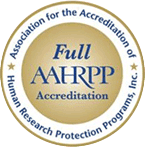Index
From the Editor: The Informed Consent Issue, Part 1
Western IRB (WIRB) Online Submission Platform Training, 11/12/20
Diversity, Equity and Inclusion in Research/Clinical Trials
Creating Informed Consent Documents: Best Practices
Exceptions to the Rule: Waivers of Consent (45 CFR 46.116(f)(3))
The Consent Summary: A Concise and Focused Description of Key Information
Herky Hint: Describing the Consent Process
In the News
From the Editor: The Informed Consent Issue, Part 1
Kelly O’Berry, BS, CIP
The Informed Consent Document (ICD) and consent process are the foundation of the ethical conduct of human subjects research. Researchers must provide enough information, in a language potential subjects can understand, so that a “reasonable person” could make a decision about whether to participate in the research. Researchers must invite subjects to participate in a research study in a manner that is free from coercion or undue influence, to allow people the freedom to choose not to participate in a study.
The November 2020 issue will cover:
- Creating a consent document
- The consent summary
- Waivers of consent
- Describing the consent process in HawkIRB
We will cover additional topics related to informed consent in the December 2020 issue of the IRB Connection Newsletter.
Western IRB (WIRB) Online Submission Platform Training, 11/12/20
Jarrod Feld, BA
During this training, a representative from WCG will provide an overview of the new WCG Connexus online portal, as well as insight and guidance for what to expect from this system. After the training, WCG will send an invitation to existing researchers and coordinators to register in the new system. Study teams can continue to use WIRB's Legacy Connexus online system at this time. This training will be recorded for future viewing.
Pre-registration is required. After you register, the Human Subjects Office will send you a separate email with the Zoom training link and a calendar invite. If you have questions, please contact Jarrod Feld or UIWIRB.
Diversity, Equity and Inclusion in Research/Clinical Trials
Kelly O’Berry, BS, CIP
They are also hosting a bi-weekly webinar series called “Practical Approaches to Improving Diversity in Clinical Trials.” It began on October 14 and runs through February 10, 2021. MRCT is posting recordings and slides on the webinar web page. Registration is managed by the MRCT.
The series will cover the following topics:
- Community Access, Awareness, Knowledge
- Workforce Development
- Study Design, Eligibility, Site Selection, Feasibility
- Study Conduct (Recruitment and Retention)
- Data Standards and Analysis
- Stakeholder Roles and Responsibilities
- Role of Data in Diversity: Genetics and RWD
Creating Informed Consent Documents: Best Practices
Kelly O’Berry, BS, CIP
There is a regulatory requirement that researchers provide enough information that a reasonable person would be able to make an informed decision about whether to participate in the research study. The Belmont Report description of the ethical principal of Respect for Persons indicates that this information needs to be presented in a language the subject understands.
A thorough, well written ICD can help subjects understand the study purpose and procedures and assist them with making a decision in their own best interest about whether to participate in the research study.
Best Practices for Creating Informed Consent Documents
Complete the HawkIRB Application First - The ICD templates are “smart forms” that have template language added based on the response to questions in the HawkIRB application. If you change a response in the HawkIRB application AFTER you generate the consent template, just generate another ICD template and compare the two documents to make sure the original document includes all the required sections.
Keep All Required Elements of Consent – You can tailor the ICD to thoroughly describe your study in a language that is readable by your subject population. But do not remove sections or information that must be presented to subjects. The IRB will not be able to approve an ICD that is missing required elements of consent.
Make Sure the ICD is Consistent With the HawkIRB Application – The Human Subjects Office (HSO) provides an Informed Consent Document Checklist to help researchers maintain consistency in the study description between the HawkIRB application and the ICD. (NOTE: To access this document, you must log in with “HawkID@uiowa.edu” and your HawkID password.) There is a link to this ICD Checklist in the HawkIRB Help message in the “Consent” Attachment category. This checklist is also posted on the Educational Tools page of the HSO website.
Check for the IRB Approval Stamp Placeholder – When you generate the ICD template, make sure you see the gray box in the upper righthand corner that will be populated when IRB approval is complete. If you are working on an Apple/Mac computer, you may not see this gray box when you open the document. Make sure you open the template in Word rather than the default text editor. There are instructions on the Human Subjects Office website to change the settings on your computer to always open rich text format (rtf) documents in Word on a Mac.
Attach a Clean Document the First Time – The first time you submit an ICD to the UI IRB, make sure it is a clean document, without any tracked changes or comments. Every time you edit the document after that, be sure tracked changes is turned on so the IRB can see all the changes.
Incorporate Sponsor Template Language into the UI ICD Template – If you receive an ICD template from a sponsor, generate the UI ICD template in HawkIRB and insert the sponsor’s template language into the UI IRB document. It is always a good idea to obtain sponsor approval for the ICD BEFORE you attach the ICD to the New Project form and each time the document is revised during the IRB review process. This can prevent back and forth with the sponsor after the IRB review process is complete.
You Can Have Multiple Consent Documents – If you are enrolling different subject populations who are doing different study procedures, it makes sense to prepare separate ICDs for each population. Make sure the difference between the documents is clear in the filename and in the title section of the document (under the study title) or in the footer, so that research team members use the correct version when they conduct the consent process.
Use Plain Language for a Lay Audience – Potential subjects will not necessarily be experts in your field of study. Avoid using jargon that subjects may not understand. If you must use technical or scientific terms, be sure to define them. Use simple language to describe your study. You may have to simplify the language even further if you are enrolling people with a low reading or education level or people with cognitive impairment that might affect their ability to read and understand the study description.
Proofread and Request Feedback – It can be useful to read your draft ICD out loud and think about how it might sound to your potential subjects. You can also give it to a friend or relative and request feedback from someone who is not an expert in your field. It is especially important to proofread the ICD when you make edits during the IRB review process. In the “Review” tab, under “Tracking,” turn off “Mark Up” to see what the document will look like when the IRB accepts the tracked changes. This can help you catch extra periods or weird spacing that will affect how the document appears to your potential subjects. We recommend proofreading a clean version of your ICD before the first submission and every time you edit the document during the IRB review process.
Use Tables and Charts to Present Information – It can be much easier for potential subjects to absorb and understand what happens at each study visit by looking at a table or chart. It might take several paragraphs to explain what you can show in a single table. A table or chart can be an easier reference for enrolled subjects to review during the study to see what will happen at each study visit.
Write in Active Rather Than Passive Voice – It is much easier for subjects to understand sentences written in active voice. According to the Purdue Online Writing Lab, using active voice makes your sentences more clear and less wordy. The University of Wisconsin-Madison Writing Center website suggests that passive voice sentences can be vague and “lead to a tangle of prepositional phrases.” Here is an example of passive and active voice in an ICD:
- Passive Voice: Your pain can be reduced by administration of topical analgesics and use of distraction techniques.
- Active Voice: You may use topical analgesics and distraction techniques to reduce your pain.
Human Subjects Office Staff are available to assist UI researchers with creating the best possible ICD to present all the information potential subjects need in a language they can understand.
Exceptions to the Rule: Waivers of Consent (45 CFR 46.116(f)(3))
Joanie Hoefer, BS, CIP
Obtaining informed consent from subjects prior to their participation in research is a basic, ethical obligation for the conduct of human subjects research. But some situations can make the possibility of getting consent from subjects unlikely. There are three types of waivers of consent that the UI IRB may grant with the required and appropriate justification.
Full Waiver of Informed Consent
With a full waiver of informed consent, there is no consent document or consent process. Subjects are not given information about the study or a choice about whether their data or specimens can be used for research purposes. This type of waiver is commonly granted for retrospective record reviews, use of archived specimens or secondary data analysis. This type of waiver cannot be granted if data or specimens will be collected prospectively or if the study involves a drug, device, biologic, or other product regulated by the Food and Drug Administration (FDA).
In order to grant this waiver, the principal investigator (PI) needs to demonstrate that ALL the following apply:
- The research involves no more than minimal risk to the subjects.
- It would be impracticable (not possible) to conduct the research without the waiver.
- If the research involves the use of identifiable private information or biospecimens, and it would be impracticable (not possible) to conduct the research without the use of the identifiable information or biospecimens.
- The waiver will not adversely affect the rights and welfare of the subjects.
- Whenever appropriate, the subjects will be provided with additional pertinent information after participation.
To request a full waiver of informed consent, select the ‘Yes, for all subjects’ option in Section IV.3 of the HawkIRB application. Additional questions will open for the PI to provide justification for the full waiver of consent.
In some instances, the PI may want to request a waiver of informed consent for some subjects but obtain informed consent from others. An example would be if a study involves a secondary data analysis of existing records along with the prospective collection of new data. In Section IV.3, select the ‘Yes, but only for some of the subjects’ and provide justification for the waiver of consent.
Waiver of Elements of Informed Consent
A researcher can request a waiver of one or more elements of informed consent when they need to withhold certain information about the study that might affect how subjects participate in the study. Examples might be if the researcher wanted to withhold the true purpose of the study or tell the subjects that they will be working with another study participant when actually they will be working with a trained, study confederate. This is called a “deception” study when there is incomplete disclosure of information prior to or during the conduct of the study. There is still a consent document and consent process, but subjects do not receive complete information about the purpose or study procedures prior to giving consent. Researchers may also wish to request a waiver of elements for parental consent. For example, a study may request to waive parental permission for teen mothers who are enrolling their children and will also be subjects in the study.
There are a few things to be aware of when requesting a waiver of one or more elements of consent. The PI will need to complete Section IV in the following manner to request this waiver:
- IV.3—select ‘Yes, but only for some of the subjects’ so that the sections of the application about recruitment, consent and study procedures remain open.
- IV.5—select “Other” and put “waiver of elements of consent” in the open text field and describe what information will be withheld from subjects.
The remainder of the questions in Section IV are the same as the questions for a full waiver of informed consent. The PI must provide an adequate justification for the waiver of elements of informed consent.
Waiver of Documentation of Consent (45 CFR 46.117)
With a waiver of documentation of consent, there is still a consent document and consent process, but subjects do not sign the document. Instead, subjects verbally agree to participate, or click a button in a web-based survey or complete the research activities.
There are three circumstances in which the IRB may waive the requirement for the investigator to obtain a signed informed consent form from some or all subjects if any of the following conditions apply:
- The only record linking the subject and the research would be the informed consent document and the principal risk would be the potential harm resulting from a breach of confidentiality.
- The research presents no more than minimal risk of harm to subjects and involves no procedures for which written consent is normally required outside of the research context.
- If the subjects or legally authorized representatives are members of a distinct cultural group or community in which signing forms is not the norm, the research presents no more than minimal risk of harm to subjects and provided there is an appropriate alternative mechanism for documenting that informed consent was obtained.
The study must meet all parts of the at least one option above to be considered by the IRB.
The PI requests a waiver of documentation of consent in Section VII.D.16-18 of the HawkIRB application. Select the appropriate category in Section VII.D.17 and provide justification for the request in Section VII.D.18.
In studies with more than one subject population, a waiver of documentation of consent may not be appropriate for all subjects (e.g. a minimal risk study that involves both adult subjects and minor subjects). The response to VII.D.18 should indicate for which subject population the waiver is requested. Research that involves the use of any protected health information (PHI) is not eligible for a waiver of documentation of consent.
The Consent Summary: A Concise and Focused Description of Key Information
Joanie Hoefer, BS, CIP
The revised Federal Regulations for the Protection of Human Subjects (Common Rule) includes a new requirement that investigators provide a concise and focused summary of essential information that a reasonable person would want to know when deciding to participate in a study. This summary is designed to assist potential subjects with the decision about whether to participate in studies that have long and complex Informed Consent Documents (ICDs).
The addition of this requirement was due to the growing concerns that consent forms have gotten too long and complicated to adequately convey the information potential subjects need to make an informed decision about their participation in the study. The key information summary, also known at the UI as the consent summary, must be presented to potential subjects before providing them with the Informed Consent Document (ICD). This summary should include the information that would most likely help a prospective subject, or their legally authorized representative, understand the reasons why they might or might not want to participate in the study.
Key Information Is…
The Preamble to the revised Common Rule suggests five elements (key information) that a potential subject would want to know prior to reading the full ICD:
- The fact that consent is being sought for research and that participation in the research is voluntary.
- A general summary of the purposes of the research, the expected duration of participation and the main procedures that will happen in the research.
- The reasonably foreseeable risks or discomforts to the potential subject.
- The benefits to the prospective subject or to others that may reasonably be expected from the research.
- If there are any appropriate alternative procedures or courses of treatment that might be advantageous to the potential subject, if applicable.
Complete details of these elements and any additional relevant pieces of information still need to be provided in the ICD. For example, you would only want to describe those risks which may be the most likely to occur or the most serious in the consent summary, and then provide a complete, detailed description of any additional risks in the ICD.
Currently, there is no federal regulatory guidance defining key information or specifying what should be in the consent summary. What constitutes key information will be unique to each research study based on the study design, procedures and subject population(s). For example, the key information for a Phase II clinical trial of an investigational drug will be very different from the key information needed to decide to participate in a longitudinal study of the effect of exposure to environmental toxins over the course of 20 years. Investigators and/or the IRB may decide that additional or different information should be included after considering the needs and interests of the subject populations and/or study design. The consent summary is an opportunity to translate how the study may impact a subject’s daily life and to ‘connect the dots’ for that potential subject.
Key Information Is Not…
The key information provided in the consent summary is not intended to replace the ICD. Nor is the discussion of the key information a substitute for the entire consent process. Investigators remain responsible for providing additional information that may not be provided in the consent summary to subjects when they request it if this helps with their decision regarding participation. Investigators must still be ready to answer any additional questions subjects may have.
Writing the Consent Summary
The consent summary should be written in clear, plain language. You should state what needs to be said without using unnecessary words. Do not simply copy and paste information from the ICD into the template. The information should be presented in a way that helps the individuals understand the information. This could be in the form of simple tables, charts or graphics.
When creating the consent summary, it is important to consider any potential barriers that may hinder a potential subject’s comprehension of the information:
- Research may be a new experience for them.
- If they have a new diagnosis, they may not even understand the disease yet.
- They may feel uncomfortable or embarrassed asking questions.
- They may not even know what questions to ask.
- Low level of literacy and/or health literacy (the degree to which individuals understand basic health information to make appropriate health decisions)
The summary should be no longer than 1-2 pages. The UI IRB provides three key information (Consent Summary) templates:
- General Consent Summary for Clinical Trials is used for any study that requires the use of a summary of key information, not just clinical trials.
- Phase 2 Consent Summary is used specifically for Phase 2 clinical trials.
- Phase 3 Summary for Clinical Trials is used specifically for Phase 3 clinical trials.
Use these templates as a guide. You may want, or need, to include additional information depending on the study procedures and subject population. The templates are available in the drop-down menu of the Consent and Assent Forms section of the Attachments Page in the HawkIRB application. Describe how the consent summary will be used in Section/s VII.D. 29 and/or VII.D.30 of the HawkIRB application and attach the it in the ‘Other Consent Document’ section of the attachments page.
When to Use a Consent Summary
You must use a key information summary:
- For any federally funded research supported by an agency that signed on to follow the Common Rule.
- Per UI IRB policy, for any FDA-regulated research as long as it’s content is not inconsistent with FDA regulations. (The FDA regulations currently do not require a consent summary.)
Per UI IRB policy, for any study, regardless of the funding source, if the ICD is more than 4 pages long.
Herky Hint: Describing the Consent Process
Joanie (Neyens) Hoefer, BS, CIP
It is important to provide the IRB with a complete and detailed description of the entire consent process. To approve the study, the IRB needs to assess that consent is sought from each participant or their legally authorized representative in accordance with the regulations and that it has been appropriately documented. The description of the consent process is captured in Section VII.D of the HawkIRB application. This article highlights the questions related to the consent process.
Section VII.D.8-11
The consent process begins with the recruitment message. This could be when a person responds to recruitment materials or a member of the research team approaches someone about being in a study (e.g. a patient in a clinical setting). In Section VII.D.8-11, the IRB asks if the study will be discussed with the potential subject in-person or by phone. The location of an in-person discussion should provide privacy for the individual to ask questions and discuss the details of the study. If the study will be discussed over the telephone, describe the nature of the phone contact.
Section VII.D.15
The IRB needs to review and approve all materials that will be used during the consent process. In Section VII.D.15, select one or more of the following options:
- Consent Document - This is the ‘standard’ form for obtaining informed consent.
- Letter or Information Sheet Containing Elements of Consent - This form can be used when the IRB has granted a waiver of documentation of consent.
- Assent Document - This is a simplified description of the study and is used for young children and cognitively impaired adults.
- Verbal/Phone Script - This is generally used when consent will be obtained over the phone. However, there may be other instances in which a verbal script might be used (e.g. a researcher is working with a subject population that has low literacy). The researcher should request a waiver of documentation of consent if consent will be obtained verbally from subjects.
- Exempt Information Sheet - This form can ONLY be used when the study qualifies for Exempt Status (Selected in Section IV.1) as the Exempt Information Sheet does not contain all the required elements of consent.
- Other - This includes materials that are not already listed such as diagrams, flow charts, PowerPoint presentations, etc.
Make sure the materials attached to the application are consistent with the option/s selected in Section VII.D.15.
Section VII.D.27
Potential subjects should be given enough time to think about whether they would like to participate in the study and be able to discuss the study with family and friends before deciding. Describe this in Section VII.D.27. There is no right or wrong amount of time that persons should be given to make their decision about participating in research. Generally, the length of time should be appropriate based on the length and complexity of the study and the risks involved. For a complicated or high-risk study, if this length of time is very short the IRB will request justification.
Section VII.D.29
Provide a thorough description of the consent process for ADULT subjects in Section VII.D.29. Do not simply state “Consent will be obtained.” Researchers generally have a detailed and thoughtful consent process in mind, but it is not always articulated in the HawkIRB application.
Questions to consider when writing the description of the consent process include:
- How will the research team use the documents selected in VII.D.15 and when do potential subjects receive these documents?
- Are potential subjects given time to read the document?
- Does someone on the research team review the document with subjects?
- How does the subject indicate their consent to participate? Do they sign the Informed Consent Document? Will they verbally agree? Etc.
If consent is obtained by postal mail or email, the details of this process and any follow-up contacts must be described. It is always a possibility that the consent document may be returned incomplete or incorrectly completed. Researchers should have a plan to return the consent form to the subject for corrections and describe that plan fully in this response.
Researchers must describe how they plan to reduce the possibility of undue influence and/or coercion during the consent process .
- Undue influence is anything that makes the subject feel they are not free to choose whether to participate in the study. This influence can be intentional or unintentional and it can come from someone on or outside of the research team.
- Coercion is a threat of harm or loss of benefits to the subject.
Coercion and undue influence can be minimized in numerous ways. For example, discussing the study with the subjects and reviewing the entire consent document with them, allowing them to ask questions before consent and throughout the study, emphasizing that they are free to not participate or end their participation at any time and checking in with them frequently throughout the study to see if they want to continue. It is best for someone other than an authority figure to the potential subject to conduct the consent process. Authority figures could include health care providers, course instructors, supervisors, etc.
Section VII.D.30
Provide a thorough description of the consent process for the PARENTS/LEGAL GUARDIANS of MINOR SUBJECTS in Section VII.D.30. Even if this consent process is essentially the same as for the adult subjects, do not simply say “See VII.D.29.” There could be differences in the way the consent process is conducted with parents or legal guardians.
In the News
- How to spot good Covid-19 vaccine trials results when you see them, STAT
- Neighborhood conditions associated with children’s cognitive function, National Institutes of Health News Release
- NIH study tests a comprehensive model intervention to reduce opioid overdose deaths in hard-hit communities, National Institutes of Health News Release
- COVID-19’s impact on clinical trials: Meeting participants where they are, Bill of Health, Petrie Flom Center, Harvard Law
- Positive outlook predicts less memory decline, ScienceDaily.com
- The stressful conclusion of a clinical trial, New York Times









